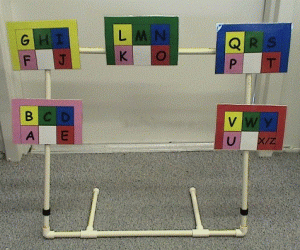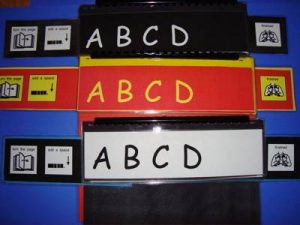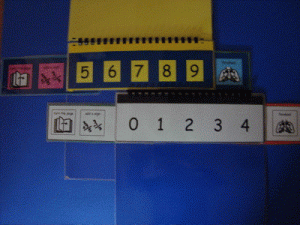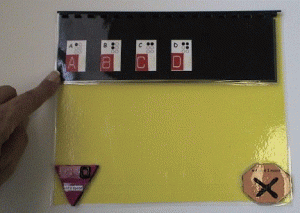Alternative Pencils
Writing is undeniably an essential component of literacy instruction for students without disabilities. Without question it is a part of their daily instruction. In order for students with significant disabilities to develop as readers and writers, daily writing is equally, if not, more important. However, this becomes a challenge when most students with significant disabilities are unable to hold a traditional pencil. To address this challenge, the Center for Literacy & Disability Studies at UNC-Chapel Hill has developed a variety of “alternative pencils” for students with the most significant disabilities, including deaf-blindness.
All the alternative “pencils” have been designed for students who are unable to hold a traditional pencil or physically manipulate a keyboard. Instead, the alternative pencils tap into students’ other developing abilities. For example, the alphabet eye gaze frame may be helpful for students who are learning to eye gaze. The print flip chart or onscreen keyboards may be helpful for students who are learning to use switches. The Braille flip chart may be useful for students who are blind. These are just a few examples. For many of the pencils, perfect vision and/or hearing are not needed.
It is especially important to note that students DO NOT need to know how to independently read or spell words in order to use any of the alternative pencils. Alternative pencils should be used with students who have a range of understandings about writing, all the way from random, emergent “scribbling” to more conventional writing with recognizable words. Children without disabilities have hundreds of hours of drawing and scribbling to help them grow into more sophisticated writers. Over the past 4 years, the same type of development has been seen with students with the most significant disabilities when they are given the same opportunities with alternative pencils. Here are some of the things we have learned about writing with students with significant disabilities, including deaf-blindness:
- Pick an alternative pencil that has the most potential for students to easily use.
- Students do not need to know their letters in order to write with an alternative pencil.
- Students need access to the full alphabet in order to learn about the alphabet.
- All students, regardless of their ability, learn about writing and alternative pencils, by writing.
- There are no prerequisites to writing. Don’t wait! Students don’t need to be ready to write. No one is “too…anything” to begin writing with an alternative pencil.
- Pick an alternative pencil below and get started now!
Alphabet Eye Gaze Frames

Print Flip Charts


Braille Alphabet Flip Chart

Below are files required to create two of the most widely used alternate pencils. They are intended to get you started, but you may have to develop other alternatives for your students.
Eye Gaze Frames
- Lower Case Card Color Coded Eye Gaze Frame
- Lower Case Letter Color Coded Eye Gaze Frame
- Upper Case Card Color Coded Eye Gaze Frame
- Upper Case Letter Color Coded Eye Gaze Frame
- Upper Case Position Coded Eye Gaze Frame
Flip Charts
Guide to Using the Print Flip Chart
Partner Assisted Scanning Tips
- Lower Case Black Letter Blue Yellow Flip Chart
- Lower Case Black Letter Flip Chart
- Lower Case White Letter Flip Chart
- Lower Case Yellow Letter Flip Chart
- Number Black Letter Flip Chart
- Number Black Letter Blue Yellow Flip Chart
- Upper Case Black Letter Blue Yellow Flip Chart
- Upper Case Black Letter Flip Chart
- Upper Case White Letter Flip Chart
- Upper Case Yellow Letter Flip Chart